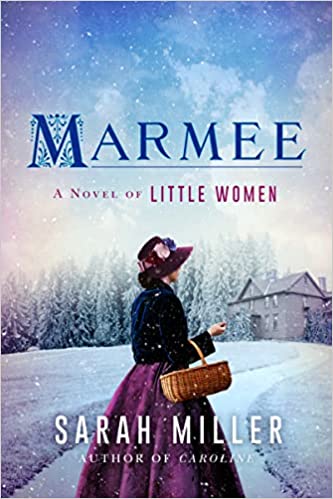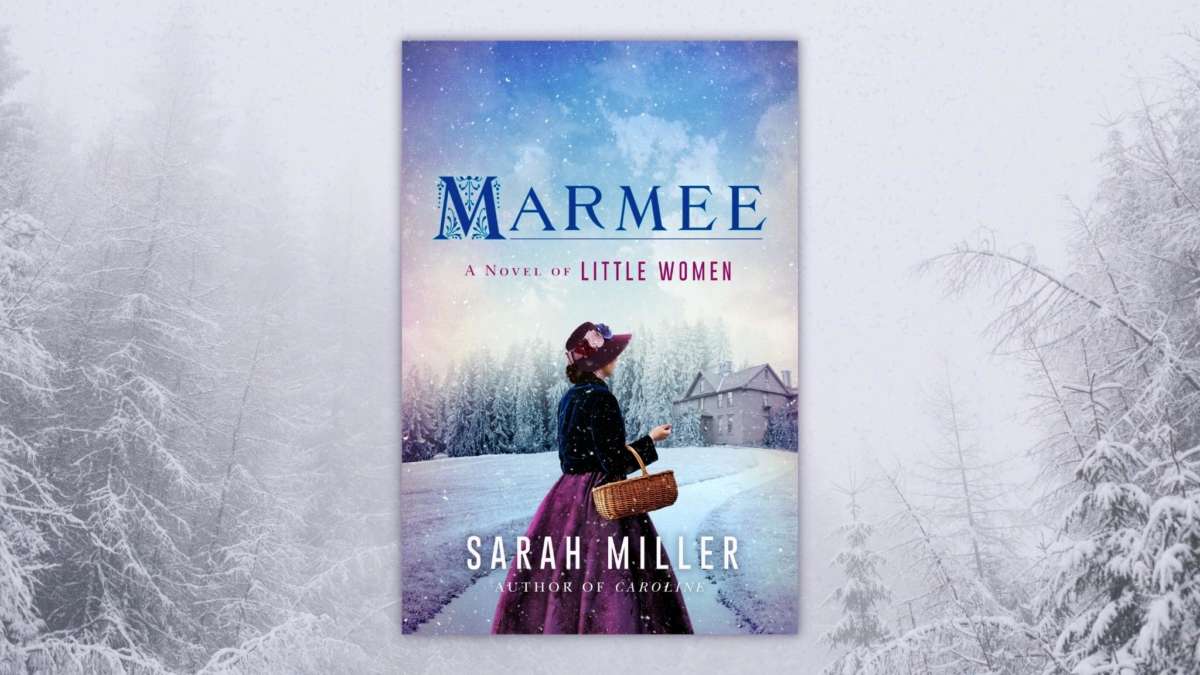Marmee by Sarah Miller
Most Little Women fans know that Louisa May Alcott based the Marches on her own family. But just how autobiographical is this classic coming-of-age story of four sisters during the Civil War?
Sarah Miller, the author of Marmee, A Novel of Little Women (William Morrow), believes that because Alcott wrote Little Women for children, she deliberately omitted some of the depth and nuance of her family members. “Louisa May Alcott was writing for children at a time when children’s literature was overwhelmingly didactic,” says Miller. “She felt obligated to insert the expected dose of morality into the story.” She continues, “The character of Marmee bears that burden — much to our detriment. I made it my aim to round out Margaret March so that her character feels more like a person and less like a deity of effortless goodness.”
Miller’s immersion into Alcott family history produces a rich and compelling page-turner in Marmee. The author’s depiction of the matriarch reflects Louisa’s mother, Abba May Alcott, adding a decided edge and complexity to the character, mainly because of Abba’s volatile personality and passion for causes. “Abba May Alcott was a radical, for heaven’s sake,” says Miller, ‘She was a pioneer in what would become the field of social work.”
A WOMAN’S STRUGGLE IN AN UNCERTAIN TIME
Fans of Little Women unfamiliar with the Alcotts need not know the family’s backstory to enjoy this book. Through the mechanism of a personal diary, Marmee tells her life’s story with her husband and daughters, her volunteer efforts for the Civil War and her care of destitute neighbors, the Hummels. Marmee’s dedication to social justice and progressive reform is her life’s work, not unlike her husband’s vocation as an ordained minister. She is equally committed to her daughters, particularly their moral upbringing. Marmee notes the faults her girls must overcome, such as vanity, shyness and selfishness.
Anger management is a large part of Marmee’s story. Miller believes her character’s admission in Little Women of being angry nearly every day of her life” is “seismic in its insight into Margaret March’s character.” Thus, Marmee worries most over Jo’s temper, which is so much like her own: “Only Jo does not recognize her true burden … The way she flares … when something ignites her anger, makes me wince. I have singed too many people I love with the sparks of my own temper.”
Marmee recognizes that Jo is not the only daughter with anger issues. Amy’s notorious act of burning Jo’s manuscript has caused her mother great concern: “What a woeful inheritance I have bequeathed to my two girls: Jo, the flare, and to Amy, the smolder, of my unquenchable temper.” She explains further: “Jo lashed out in a blind fury, while Amy took the time to seek the revenge that would wound her sister most deeply. Amy’s sense of proportion, so keen in her drawings, fails her entirely elsewhere in life.”
GIVING GRACE TO TWO MALIGNED CHARACTERS
The diary format of this book allows Miller to share her rich insights into the characters of Little Women. In particular, by imagining their inner lives in depth, she redeems the two most misunderstood daughters, Amy and Beth.
Readers have disparaged Amy because she burned Jo’s manuscript and married Laurie, but there is so much more to Amy than these factors. Miller illustrates this in part through the character of the curmudgeonly Aunt March. Marmee can barely tolerate her aunt because of the constant criticism. Amy, however, has developed an affection for the elderly woman. She demonstrates this through a portrait she drew as Marmee recounts: “For perhaps the first time, Amy has created an image that does not simply replicate something beautiful, but instead expresses something beautiful. For it to be something I myself have never had occasion to observe makes the picture all the more captivating. I am so used to tolerating Aunt March that it is difficult for me to imagine the fondness with which Amy has so clearly drawn her. Put simply, Amy’s is an Aunt March that I would like to meet.”
Shy Beth is the character often dismissed, particularly by feminists, because she represents the saintly invalid who practically wills herself to die. However, Miller’s imagining of Beth’s interior life reveals a strong, courageous young woman, always true to herself even though she prefers to live in the shadows. Marmee reflects on Beth months after her death: “I have been wrong all these years to equate Beth’s contentment with surrender. Contentment need not be a gentle form of giving up. This is what I learned from Beth. It has not made me crave less of the world, but more accepting of those, like Beth, who find all they need within a small sphere. What I saw as narrowness and structure was, in reality, depth. She loved few things, and loved them deeply: her dolls, her kittens, her music, and her Family.”
EXPANDING ON A CLASSIC
Marmee muses on more than her immediate family; she also writes in detail about Hannah, the servant, and the Hummels. These minor characters played crucial roles in advancing the plot in Little Women; Miller has expanded their stories into fascinating and believable subplots, adding a new layer of richness to Marmee’s story.
This book is a treasure trove for those who have studied the Alcott family. Miller sprinkles subtle Easter eggs throughout the text, sure to bring a smile to Alcott enthusiasts. She does not gratuitously use these facts but weaves them skillfully into the story.
At 415 pages, Marmee, A Novel of Little Women is a lengthy and delicious read. I was sorry to see this book end and look forward to rereading it. Sarah Miller has crafted a triumph in Marmee. It’s a must-read for any Little Women/Alcott fans.
Q&A WITH SARAH MILLER
Q: Your research on this book is thorough and impeccable — you read the best biographies out there. How long did it take you to conduct the research for “Marmee?”
A: I started the minute my editor suggested this project (it was her idea!) and didn’t stop until the copyedits were done, and I wasn’t allowed to tweak it anymore. So, a little more than two years. For a while, I had to proceed without the archival research because COVID-19 restrictions made the materials at Harvard’s Houghton Library inaccessible. That was a nail-biting experience. Starting a draft when I know there’s more information out there is almost painful. Thankfully, Eva LaPlante’s work on Abba May Alcott filled that gap until I could access the Alcott papers.
Q: You listed one primary source from Houghton — “Memoir of Abigail May Alcott” written by Bronson Alcott. In your book, you made mention of Amos’s handwriting: “Pgs. 112-113 — it is visible in his handwriting. From one letter to the next, the words might have been formed by two different men colon one composed and measured and graceful income, and the other scratched out and hurried pencil.” Was this visible in the “Memoir of Abigail May Alcott?” I had seen evidence of this in Bronson’s journals from time to time.
A: I’m thunderstruck because I made that detail up! But I can tell you that my heart soared when I saw that the handwritten title page of the Memoir was written in red ink – something Bronson saved especially for subjects of great importance to him.
Q: How many times have you read “Little Women?” Did you read it during different times in your life, and if so, did you get something new out of the book? Have you seen the movies, and did they influence your research?
A: Please don’t be appalled when I confess that before starting Marmee, I had read Little Women exactly … once. I embarked on the research by immediately listening to the novel repeatedly on audio. The spoken word gives me a much better grasp of the style and cadence of the writing and somehow allows me to zoom in on those tiny openings in the original plot and characters that are essential to attempt a retelling. (Maybe when your brain doesn’t have to decode symbols on a page, it has more freedom to picture the story?)
As for the movies, I made sure to watch every film version I could lay my hands on. It was unexpectedly informative to consider each one and see what elements and portrayals resonated most deeply, and which ones seemed to miss the mark from one version to another. In the end, I had a favorite Meg, Jo, Beth, Amy, and even Professor Bhaer, but no favorite Marmee. All of them seemed to be missing something.
Q: Which March sister fascinates you the most and why?
A: Oh, what a wicked question! I’m supposed to say Jo — we’re all supposed to say, Jo, right? The questions her character raises about gender alone can and do fill articles and theses. But I think my choice within the context of writing this novel might actually be Beth. Her inner world is the most hidden in Little Women, giving me much more to explore.
Q: Your approach towards Beth was quite thoughtful and does much to put her in a more favorable light, as she has been disparaged by feminists in the past. What was your thinking as you explored her character?
A: Beth’s shyness comes off almost as a charming quirk in Little Women, but if you step back and look more objectively, it’s clear that there has to be more to it than that. Being too shy for school is beyond a quirk — especially in a family where education was so prized. From a current perspective, it looks very much as though Beth is living with a considerable level of anxiety. All that led me to wonder how someone as forceful, confident, and community-minded as Marmee parents a child who can barely tolerate leaving the house.
Q: In your book, it feels like you are writing more about Abigail Alcott than “Marmee” from “Little Women.” Was this intentional? I saw so much of Abigail in Marmee’s words.
A: 100% intentional. Louisa May Alcott’s Marmee is so heavily based on Abba May Alcott, and yet there’s so much of Abba May Alcott that never made it into Little Women. My theory is that because Louisa May Alcott was writing for children at a time when children’s literature was overwhelmingly didactic, she felt obligated to insert the expected dose of morality into the story. (Proof? Speaking through Jo in Jo’s Boys, Louisa May Alcott expressed her frustration with being relegated to “a literary nursery-maid who provides moral pap for the young.”) So the character of Marmee bears that burden – much to our detriment, I think. Abba May Alcott was a radical, for heaven’s sake, and a pioneer in what would become the field of social work. I made it my aim to round out Margaret March so that her character feels more like a person and less like a deity of effortless goodness.
Q: Your insights into each of the March sisters were compelling. How did your research influence your ideas about the sisters?
A: Thank you! I don’t know how much was research and how much was instinct, to be honest. Anne Boyd Rioux’s book, Meg, Jo, Beth, Amy: The Story of Little Women and Why it Still Matters, provided excellent guidance in that regard. Since I as a reader didn’t have a deep personal history with the original text to draw upon, I prioritized learning what aspects of each sister were most cherished by devotees of Little Women (as well as what aspects were most criticized). That’s the trickiest part of a retelling or an alternate perspective — if those familiar, beloved personalities aren’t immediately palpable, or if they act out of character, you’re sunk.
A big part of what I did is to simply assume that the very aspects of each sister that have quietly frustrated generations readers would also cause their mother some level of consternation: Meg’s conventionality, Jo’s temper, Beth’s shyness, Amy’s self-centeredness. Acknowledging those characteristics as potentially troublesome rather than just charming idiosyncrasies opens up a whole new realm of possibility. How do these fundamental traits help or hinder each of Marmee’s daughters, and how can she steer them (gently, of course) toward their greatest potential?
Q: What is your opinion of Bronson Alcott? You draw Amos as quite a sympathetic character even as you have Marmee pointing out his faults at times.
A: That man would have driven me to utter despair if I were married to him, though I will admit that I do find the actual Bronson Alcott as admirable as he is infuriating. He stood for his principles like few others.
Bronson/Amos was another balancing act for me in Marmee. She loves him fiercely, but he’s constantly making her life more difficult with his fundamental disregard for and detachment from nearly all things practical. Hitting the right combination of devotion and irritation was essential.
Q: One of the best parts of your book was the time you spent exploring anger issues. Your insight regarding both Jo and Amy sharing Marmee’s temper was amazing. What motivated you to focus on this issue?
A: That moment in Little Women when Marmee tells Jo, “I am angry nearly every day of my life,” is seismic in its insight into Margaret March’s character. Anyone who studies her ignores it at their peril. That internal struggle is what makes a novel like this possible at all — you think you know Marmee, but there’s another whole world within her that she’s barely containing. And the fact that this temper is drawn directly from Abba May Alcott’s personality is more intriguing still. This was real. I’d go so far as to say that if you’re not looking at Margaret March through that lens, you’re not really seeing her.
Q: I loved the subplots with the Hummels and Hannah — what made you decide to build on their stories?
A: Oh, hooray! I so enjoyed writing those.
With Hannah’s subplot, I wanted to answer a glaring question: How on earth do these people who are so “poor” afford a live-in maid for decades? From there, it seemed natural to suppose that Margaret (Marmee) and Hannah would have developed a deep friendship after all those years.
As for the Hummels, there’s a line in one of the later March family novels that refer to “Nursey Hummel” being employed at Jo’s school. That was a glaring beacon — a signal that the relationship between the Marches and the Hummels lasted for years. (That’s also where Asia, Mary Ann, and Silas came from!)
Q: Have you visited Orchard House? If you have, what did you think of it?
A: I did! Due to COVID, it took until October of 2021 to get there, but I made it. Visiting the real-life scene of something you’ve studied for so long is always surreal. I mean, you know that Amy/May drew on the walls and burned a portrait into the breadboard, but there they are, right on the walls and the breadboard. They really exist. And Jo’s sausage pillow! And there are always things you can’t learn anywhere but on-site, like the pattern of the quilt on the Alcotts’ bed or the titles of the books on their shelves.
RELATED POSTS:
Letters From “Little Women” Craft Intimacy Between Reader and Alcott’s Beloved Characters
Two Renowned Writers of the 19th Century Correspond in This Historical Reimagining
Early Bird Books: 8 Books for Fans of Little Women
 About Sarah Miller:
About Sarah Miller:
Buy this Book!
Amazon





Sounds like an intriguing book!
It is!
Thank you for this interview and enticing book review. Your questions highlight intriguing aspects that a briefer review would miss. Eager to read more from both of you!
Thank you! There are links down below of other books I have reviewed for this site, plus articles about the Alcotts. Hope you enjoy “Marmee.”